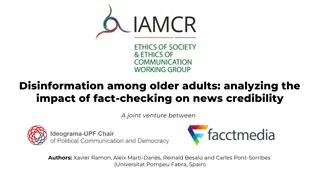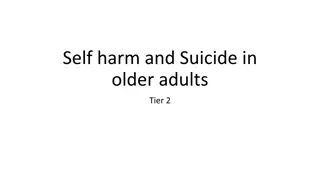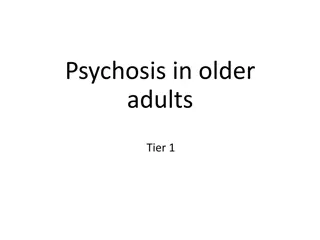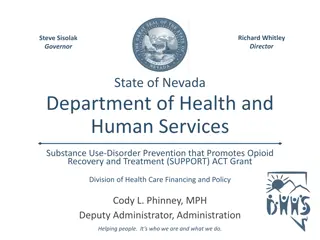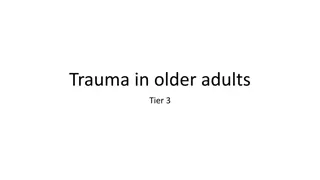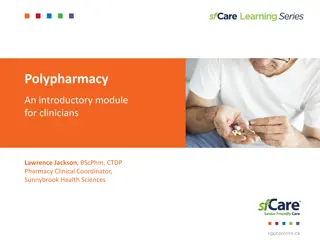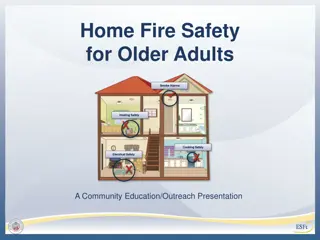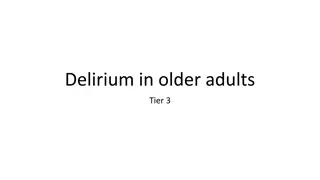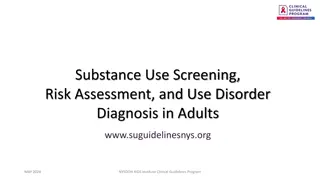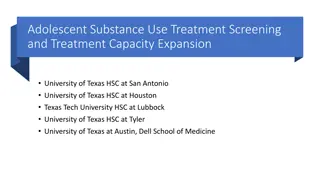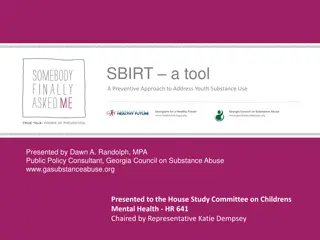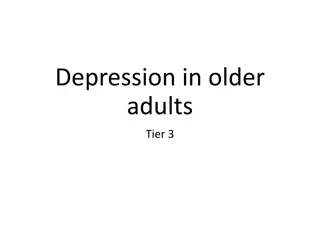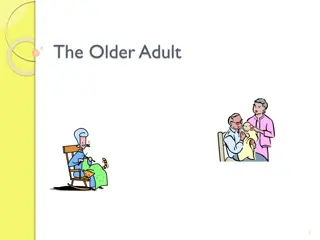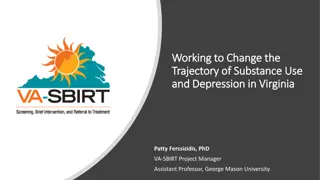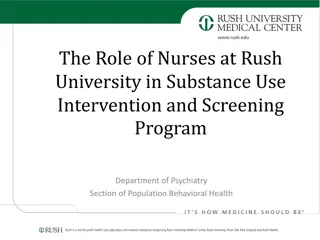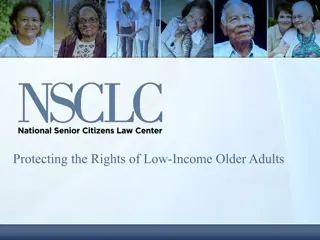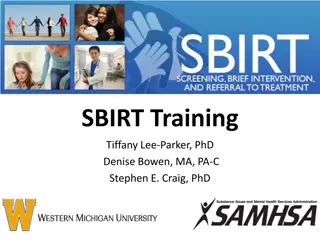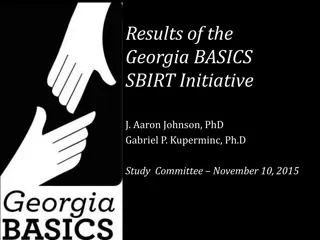SBIRT+: Tailoring Substance Use Intervention for Older Adults
SBIRT+ is a targeted training approach focusing on Screening, Brief Intervention, and Referral to Treatment to meet the unique needs of older adults, addressing risky substance use in the elderly population. It aims to address the growing concern of alcohol use and medication misuse in Baby Boomers while preparing for future health outcomes. This initiative emphasizes the importance of early interventions to improve health and prevent future issues related to substance use disorders in older adults.
Download Presentation

Please find below an Image/Link to download the presentation.
The content on the website is provided AS IS for your information and personal use only. It may not be sold, licensed, or shared on other websites without obtaining consent from the author. Download presentation by click this link. If you encounter any issues during the download, it is possible that the publisher has removed the file from their server.
E N D
Presentation Transcript
Screening, Brief Intervention, and Referral to Treatment for the Special Needs of Older Adults (SBIRT+) The University of Iowa College of Nursing With funding from the Substance Abuse and Mental Health Services Administration (SAMHSA)
Brought to you by SBIRT-TIPS: Screening, Brief Intervention, and Referral to Treatment Training Iowa Preceptors and Students 3-year training project at the University of Iowa Doctor of Nursing Practice (DNP) students Physician Assistant (PA) students Preceptors for DNP and PA students statewide Funded by SAMHSA, 2015 to 2018
Goals for today Review features of SBIRT+ (Plus), the older adult SBIRT initiative in Iowa Discuss characteristics of older adults that create unique risks for substance use Demographic trends Universal aging changes Health problems/medication use Social stress and loss Implications for practice
What is SBIRT? The primary goal of SBIRT is to identify and effectively intervene with those who are at moderate or high risk for psychosocial or health care problems related to their substance use.
What is SBIRT? An evidence-based practice that targets risky substance use Screening: Two-step screening for quickly assessing use of alcohol, illicit drugs, and prescription drug use, misuse, and abuse Brief Intervention (BI): Brief motivational and awareness- raising intervention given to risky or problematic substance users Referral to Treatment: Referrals to specialty care for patients with substance use disorders
SBIRT+ SBIRT+: A training approach that tailors SBIRT to address the unique needs of older adults Alcohol use in late life is largely IGNORED, even though health consequences are HIGH Risky use of alcohol (and misuse of medication, along with illicit drug use in Baby Boomers) is a GROWING concern Making changes NOW can help ease suffering AND prepare for the future!
Why is SBIRT+ Important? The social and physical changes that accompany aging may well increase vulnerability to drug-related problems. Slowing metabolism can increase sensitivity to the effects of drugs. Volkow, 2011 Age-related health conditions and medications may influence the effects of use/misuse of substances Certain events such as loss of loved ones, retirement, and health-related issues may contribute to older adults using alcohol/drugs as self-medication, particularly if the person has a history of using substances to cope
Demographic Facts: Age Wave Silver Tsunami: Rapidly increasing number of older adults Individuals 65 increased by 10M between 2004 and 2014 to > 46.2M In 2015, 1 of 7 Americans was an older adult Those who reach age 65 have an average life expectancy of 19.3 years You don t need to be a specialist in gerontology to be You don t need to be a specialist in gerontology to be touched by the age wave ! touched by the age wave !
Steady growth is based on the Baby Boomer generation aging. Creates changes our country has never experienced before!
Note! Trends are meaningful to our state! Note! Trends are meaningful to our state!
Living Arrangements of Persons 65+ in 2015 Consider living arrangements in the context of loss/change and risks
Demographic Facts: Substance Use Current trends: Older adults tend to prefer alcohol over illicit drugs Misuse of prescription drugs is more common than recreational use Two main groups of drinkers in later life Drank throughout their lives; now at higher risk for having health-related issues Started drinking later in life as a reaction to stress, loss, health problem; tend to be easier to treat
Demographic Facts: Substance Use Recent evidence: Illicit drug use is on the rise in older adults Substance use disorder (SUD) in > 50-year-olds will more than double by 2020 Prescription drugs with potential for abuse/misuse: Used to treat anxiety, sleep disturbances, insomnia, pain Benzodiazepines, hypnotics, opioid analgesics, skeletal muscle relaxants
Demographic Facts: Substance Use Risk factors for illicit drug abuse among older adults Young older adults, unmarried male Low income Previous illicit drug use Current methadone maintenance Licit (prescribed) drug use Alcohol use Comorbid mental illness, especially depression and/or anxiety Involvement in crime Social isolation/poor social support
SBIRT+: Understand Risks Risky Use in older people combines with other age-related health problems! Universal age-related changes (e.g., metabolism, sensory) increase risks Medical problems that cluster in late life can complicate issues Medications used to treat health-related problems interact with alcohol/drugs Loss/stress can precipitate/contribute to use
Risks: Universal Aging Changes Changes that occur in everyone/everywhere (aka normal aging changes, not disease) Over time, affects cells in every major organ Shift in muscle-to-fat ratio (sarcopenia) Metabolic slowing Sensory decline/changes: Visual (presbyopia), hearing (presbycusis) Cardiovascular: Slower heart rate, cardiomyopathy, atherosclerosis Many others!
Risks: Chronic Illness in Late Life Disease-related problems have more impact than universal changes! Musculoskeletal: Osteoporosis, falls, fractures, arthritis, degenerative joint disease Cardiovascular: Hypertension, arteriosclerosis, coronary heart disease, arrhythmias, heart failure Nervous system: Dementia, delirium, depression, Parkinson s, many others
Risks: Chronic Illness in Late Life Drinking ALONE has health consequences: Cardiac: Cardiomyopathy, arrhythmias, atrial fibrillation, ventricular tachycardia, strokes, hypertension Liver: Steatosis, alcoholic hepatitis, cirrhosis Pancreas: Pancreatitis Cancer: Mouth, esophagus, pharynx, larynx, liver, breast, colon/rectal Immune system: Suppress innate and adaptive responses
Risks: Chronic Illness in Late Life New onset psychiatric problems are associated with substance use risks, with estimated prevalence between 21% and 66% Cognitive disorders 10% 15% Anxiety disorders 10% 15% Depression* 25% *Depression and drinking is the most common comorbid problem in late life!
Risks: Depression Brief Intervention and Treatment for Elders BRITE: Project modeled after SBIRT Problems leading to referrals for BI: Alcohol use (9.7%) Illicit drug use (1.14%) Depression (64.3%); significant correlation between alcohol and depression
Risks: Medications Older adults take many medications to treat health problems Meds interact with alcohol and create risks Many adverse outcomes Common: Nausea and vomiting, headaches, drowsiness, fainting, loss of coordination, confusion (and later increase fall risk) More severe: Internal bleeding, heart problems, difficulty breathing Negative impact on prescription medications action (less/more potent)
Risks: Medications Common examples: Alcohol plus Aspirin or NSAIDS = Bleeding stomach Acetaminophen = Liver damage Cold/allergy meds = Drowsiness, impaired coordination (fall risk increases) Hypnotics, analgesics, anxiolytics = Sleepiness, poor coordination, difficulty breathing, tachycardia, memory impairment Hypertension, diabetes, ulcers, gout, heart failure meds = Makes the condition worse Questions? Check out Harmful Interactions: Mixing Alcohol with Medications (NIH/NIAA)
Risks: Loss & Social Stress Older adults drink for different reasons than younger adults High levels of stress are critical to consider! Retirement: More time and fewer responsibilities, boredom Loneliness/social isolation: Social changes that lead to boredom, sadness, anxiety, comfort-seeking Loss/Widowhood: Death of a spouse, close friend, even a pet
Risks: Loss & Social Stress Health-related changes Hip fracture: social changes Unable to drive to shop, care for home, participate in leisure activities Increased isolation, unwanted dependency Risk of drinking/drug misuse to treat distress Disabilities: Pain, depression, fear related to loss of abilities, impending death Sleep disturbances: Typical/universal sleep pattern changes treated with alcohol
Risks: Loss & Social Stress Community, Residence Changes Marital status Approximately two-thirds of men and half of women are married Roughly one-third of women and a smaller segment of men are widowed Living arrangements Approximately one-third live alone Around half of women 75 years old live alone Stress is caused by both relocation AND isolation Lots of factors may contribute to substance use Lots of factors may contribute to substance use in later life! in later life!
Implications Universal changes increase older adult s sensitivity to drinking Usual habits meaning drinking hasn t changed from midlife can result in: Higher blood alcohol levels, AND Associated adverse effects Confusion Slurred speech Impaired coordination/fall risks
Implications Sheer number of chronic illnesses in late life AND medications used to treat them puts older adults at risk! Additive effects of chronic illness and alcohol-related changes Disease/drug and alcohol interactions Social and health-related distress treated with alcohol Fear of disability, death, role changes, uncertainty Depression, anxiety Isolation, boredom
Summary of Implications Drinking can Lead to: Cancer, liver damage, brain damage (memory problems) Worsen other problems: Osteoporosis, diabetes, hypertension/CV problems, ulcers Increase risks of accidents: Falls, driving, misjudgments Make some health problems more difficult to identify/treat: Pain may be masked by alcohol Result in misdiagnosis: Confusion, forgetfulness may be mistaken as dementia
SBIRT+: Meaning in Practice SBIRT process is basically the same Adaptations tailored to older adults Use lower drinking threshold for screening Screen as needed based on observed changes in the older adult Consider late life problems when applying BI Problems/issues at baseline Root causes of substance use/related distress Involvement of community services Follow-ups by PCP or community service
SBIRT+: Same Process Completing the annual screen (<1 min), followed by the full screen (3-5 min) doesn t take much time! Annual 2-Question Prescreen Positive: Negative: Stop Full AUDIT or DAST-10 Education Sheet Low Risk: Positive Reinforcement Risky: Brief Intervention Harmful or Dependent: Brief Intervention Referral Consider comorbidities!
Note the lower limit (fewer than 4 drinks in a day) for those over 65 years Since screen is annual, it s also important to consider presenting problems !
Symptoms: Beyond annual! Unexplained complaints of chronic pain Incontinence, urinary retention, difficulty urinating Poor hygiene and self-neglect Complaints of blurred vision Changes in eating habits Unexplained nausea, vomiting Slurred speech Tremor, motor coordination problems, shuffling gait Frequent falls, unexplained bruising Sleep complaints; unusual fatigue, malaise, daytime drowsiness; apparent sedation Cognitive impairment, memory or concentration difficulties, disorientation, confusion Seizures, malnutrition, muscle wasting Liver function abnormalities Persistent irritability (without obvious cause), restlessness, agitation Altered mood, depression, anxiety
Screening/Brief Intervention AUDIT and DAST are the same Brief intervention, like adults: Based on motivational interviewing skills 5- to 15-minute semi-structured discussion Aim: Awareness and risk reduction BI tailored to older adults:Consider Health, meds, loss and stress as antecedents Depression as causal or contributing factor Community/social resources [presence/lack]
Brief Intervention BI tailored to older adults, continued . . . Drug use is mostly misuse, but still a focus! Opioids (oxycodone, hydrocodone, fentanyl, methadone) Benzodiazepines (lorazepam, alprazolam, diazepam) Stimulants (amphetamine, dextroamphetamine, methylphenidate) Sleep aids (zolpidem, zaleplon, eszopiclone) Possible stigma of mental health or substance use referrals Greater need for PCP treatment [counseling]
Brief Intervention BI tailored to older adults, continued . . . Importance of follow-up discussions Possible involvement of significant others Support, encourage decreased substance use Address causal/contributing psychosocial factors Education as an intervention Fact sheets, other printed information Discussion of risks/benefits
In Summary Screening is the first step of the SBIRT process and determines the severity and risk level of the patient s substance use The result of a screen allows the provider to determine if a brief intervention or referral to treatment is a necessary next step for the patient Provider BELIEFS about the need to screen or intervene are CRITICAL!!!
In Summary Age-related health and psychosocial risks are often influential in late life substance use Comorbid depression is common, and should be assessed Referral for assistance with managing age-related stressors is likely to be a critical component of reducing substance use/drinking Need to know aging services/point person Not just substance use referrals

 undefined
undefined




